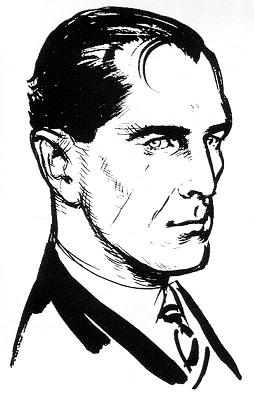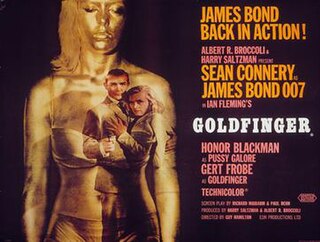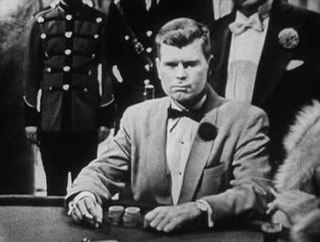
The James Bond series focuses on the titular character, a fictional British Secret Service agent created in 1953 by writer Ian Fleming, who featured him in twelve novels and two short-story collections. Since Fleming's death in 1964, eight other authors have written authorised Bond novels or novelisations: Kingsley Amis, Christopher Wood, John Gardner, Raymond Benson, Sebastian Faulks, Jeffery Deaver, William Boyd, and Anthony Horowitz. The latest novel is With a Mind to Kill by Anthony Horowitz, published in May 2022. Additionally Charlie Higson wrote a series on a young James Bond, and Kate Westbrook wrote three novels based on the diaries of a recurring series character, Moneypenny.

Ian Lancaster Fleming was a British writer, best known for his postwar James Bond series of spy novels. Fleming came from a wealthy family connected to the merchant bank Robert Fleming & Co., and his father was the Member of Parliament (MP) for Henley from 1910 until his death on the Western Front in 1917. Educated at Eton, Sandhurst, and, briefly, the universities of Munich and Geneva, Fleming moved through several jobs before he started writing.

Q is a character in the James Bond films and novelisations. Q is the head of Q Branch, the fictional research and development division of the British Secret Service charged with oversight of top secret field technologies.
M is a codename held by a fictional character in Ian Fleming's James Bond book and film series; the character is the Chief of the Secret Intelligence Service for the agency known as MI6. Fleming based the character on a number of people he knew who commanded sections of British intelligence. M has appeared in the novels by Fleming and seven continuation authors, as well as appearing in twenty-four films. In the Eon Productions series of films, M has been portrayed by four actors: Bernard Lee, Robert Brown, Judi Dench and Ralph Fiennes, the incumbent; in the two independent productions, M was played by John Huston, David Niven and Edward Fox.

Thunderball is the ninth book in Ian Fleming's James Bond series, and the eighth full-length Bond novel. It was first published in the UK by Jonathan Cape on 27 March 1961, where the initial print run of 50,938 copies quickly sold out. The first novelisation of an unfilmed James Bond screenplay, it was born from a collaboration by five people: Ian Fleming, Kevin McClory, Jack Whittingham, Ivar Bryce and Ernest Cuneo, although the controversial shared credit of Fleming, McClory and Whittingham was the result of a courtroom decision.

A Bond girl is a character who is a love interest, female companion or (occasionally) an adversary of James Bond in a novel, film, or video game. Bond girls occasionally have names that are double entendres or sexual puns, such as Plenty O'Toole, Holly Goodhead, or Xenia Onatopp. The female leads in the films, such as Ursula Andress, Honor Blackman, or Eva Green, can also be referred to as "Bond girls". The term Bond girl may also be considered as an anachronism, with some female cast members in the films preferring the designation Bond woman.

Licence to Kill is a 1989 action-thriller film, the sixteenth in the James Bond series produced by Eon Productions, and the second and final film to star Timothy Dalton as the MI6 agent James Bond. In the film, Bond resigns from MI6 in order to take revenge against the drug lord Franz Sanchez, who ordered an attack against Bond's CIA friend Felix Leiter and the murder of Felix's wife after their wedding.

Never Say Never Again is a 1983 spy film directed by Irvin Kershner. The film is based on the 1961 James Bond novel Thunderball by Ian Fleming, which in turn was based on an original story by Kevin McClory, Jack Whittingham, and Fleming. The novel had been previously adapted as the 1965 film of the same name. Never Say Never Again is the second and most recent James Bond film not to be produced by Eon Productions, the usual producer of the Bond series, but by Jack Schwartzman's Taliafilm, and was distributed by Warner Bros. instead of United Artists. The film was executive produced by Kevin McClory, one of the original writers of the Thunderball storyline. McClory had retained the filming rights of the novel following a long legal battle dating from the 1960s.

Eon Productions Limited is a British film production company that primarily produces the James Bond film series. The company is based in London's Piccadilly and also operates from Pinewood Studios in the UK.

Casino Royale is the first novel by the British author Ian Fleming. Published in 1953, it is the first James Bond book, and it paved the way for a further eleven novels and two short story collections by Fleming, followed by numerous continuation Bond novels by other authors.

"Shaken, not stirred" is how Ian Fleming's fictional British Secret Service agent James Bond prefers his martini cocktail.

Goldfinger is a 1964 spy film and the third instalment in the James Bond series produced by Eon Productions, starring Sean Connery as the fictional MI6 agent James Bond. It is based on the 1959 novel of the same name by Ian Fleming. The film also stars Honor Blackman, Gert Fröbe and Shirley Eaton. Goldfinger was produced by Albert R. Broccoli and Harry Saltzman. The film was the first of four Bond films directed by Guy Hamilton.

Dr. No is a 1962 spy film directed by Terence Young. It is the first film in the James Bond series. Starring Sean Connery, Ursula Andress, Joseph Wiseman and Jack Lord, it was adapted by Richard Maibaum, Johanna Harwood, and Berkely Mather from the 1958 novel of the same name by Ian Fleming. The film was produced by Harry Saltzman and Albert R. Broccoli, a partnership that continued until 1975. It was followed by From Russia with Love in 1963. In the film, James Bond is sent to Jamaica to investigate the disappearance of a fellow British agent. The trail leads him to the underground base of Dr. Julius No, who is plotting to disrupt an early American space launch from Cape Canaveral with a radio beam weapon.

Live and Let Die is the second novel in Ian Fleming's James Bond series of stories. Set in London, the United States and Jamaica, it was first published in the UK by Jonathan Cape on 5 April 1954. Fleming wrote the novel at his Goldeneye estate in Jamaica before his first book, Casino Royale, was published; much of the background came from Fleming's travel in the US and knowledge of Jamaica.

"Casino Royale" is a live 1954 television adaptation of the 1953 novel of the same name by Ian Fleming. An episode of the American dramatic anthology series Climax!, the show was the first screen adaptation of a James Bond novel, and stars Barry Nelson, Peter Lorre, and Linda Christian. Though this marks the first onscreen appearance of the secret agent, Nelson's Bond is played as an American spy working for the "Combined Intelligence Agency".
The James Bond film series is a British series of spy films based on the fictional character of MI6 agent James Bond, "007", who originally appeared in a series of books by Ian Fleming. It is one of the longest continually running film series in history, having been in ongoing production from 1962 to the present. In that time, Eon Productions has produced 25 films as of 2021, most of them at Pinewood Studios. With a combined gross of over $7 billion, the films produced by Eon constitute the fifth-highest-grossing film series. Six actors have portrayed 007 in the Eon series, the latest being Daniel Craig.
The James Bond series of films contain a number of repeating, distinctive motifs which date from the series' inception with Dr. No in 1962. The series consists of twenty five films produced by Eon Productions featuring the James Bond character, a fictional British Secret Service agent. The most recent instalment is No Time to Die, released in UK cinemas on 30 September 2021. There have also been two independently made features, the satirical Casino Royale, released in 1967, and the 1983 film Never Say Never Again.

James Bond is a fictional character created by the British journalist and novelist Ian Fleming in 1952. The character first appeared in a series of twelve novels and two short story collections written by Fleming and a number of continuation novels and spin-off works after Fleming's death in 1964. Bond's literary portrayal differs in some ways from his treatment in the James Bond films, of which there have been twenty-seven in total, produced and released between 1962 and 2021.

















